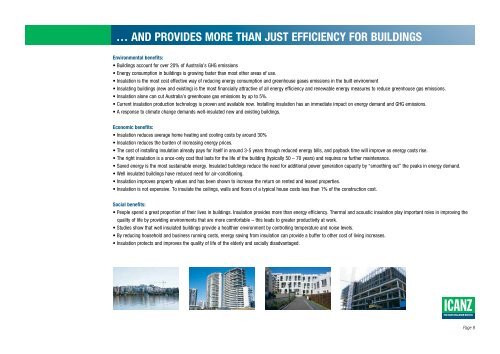INSULATION HANDBOOK Part 1: Thermal Performance - icanz
INSULATION HANDBOOK Part 1: Thermal Performance - icanz
INSULATION HANDBOOK Part 1: Thermal Performance - icanz
You also want an ePaper? Increase the reach of your titles
YUMPU automatically turns print PDFs into web optimized ePapers that Google loves.
… AND PROVIDES MORE THAN JUST EFFICIENCY FOR BUILDINGS<br />
Environmental benefits:<br />
• Buildings account for over 20% of Australia’s GHG emissions<br />
• Energy consumption in buildings is growing faster than most other areas of use.<br />
• Insulation is the most cost effective way of reducing energy consumption and greenhouse gases emissions in the built environment<br />
• Insulating buildings (new and existing) is the most financially attractive of all energy efficiency and renewable energy measures to reduce greenhouse gas emissions.<br />
• Insulation alone can cut Australia’s greenhouse gas emissions by up to 5%.<br />
• Current insulation production technology is proven and available now. Installing insulation has an immediate impact on energy demand and GHG emissions.<br />
• A response to climate change demands well-insulated new and existing buildings.<br />
Economic benefits:<br />
• Insulation reduces average home heating and cooling costs by around 30%<br />
• Insulation reduces the burden of increasing energy prices.<br />
• The cost of installing insulation already pays for itself in around 3-5 years through reduced energy bills, and payback time will improve as energy costs rise.<br />
• The right insulation is a once-only cost that lasts for the life of the building (typically 50 – 70 years) and requires no further maintenance.<br />
• Saved energy is the most sustainable energy. Insulated buildings reduce the need for additional power generation capacity by “smoothing out” the peaks in energy demand.<br />
• Well insulated buildings have reduced need for air-conditioning.<br />
• Insulation improves property values and has been shown to increase the return on rented and leased properties.<br />
• Insulation is not expensive. To insulate the ceilings, walls and floors of a typical house costs less than 1% of the construction cost.<br />
Social benefits:<br />
• People spend a great proportion of their lives in buildings. Insulation provides more than energy efficiency. <strong>Thermal</strong> and acoustic insulation play important roles in improving the<br />
quality of life by providing environments that are more comfortable – this leads to greater productivity at work.<br />
• Studies show that well insulated buildings provide a healthier environment by controlling temperature and noise levels.<br />
• By reducing household and business running costs, energy saving from insulation can provide a buffer to other cost of living increases.<br />
• Insulation protects and improves the quality of life of the elderly and socially disadvantaged.<br />
Page 8


